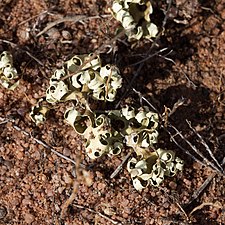| Resurrection lichen | |
|---|---|

| |
| Comparison of dry and wet form | |
| Conservation status | |
 Declining (NZ TCS) | |
| Scientific classification | |
| Domain: | Eukaryota |
| Kingdom: | Fungi |
| Division: | Ascomycota |
| Class: | Lecanoromycetes |
| Order: | Lecanorales |
| Family: | Parmeliaceae |
| Genus: | Xanthoparmelia |
| Species: | X. semiviridis |
| Binomial name | |
| Xanthoparmelia semiviridis (F.Muell. ex Nyl.) O.Blanco, Ana Crespo, Elix, D.Hawksw. & Lumbsch) | |
| Synonyms | |
| |
Xanthoparmelia semiviridis, also known as resurrection lichen is a foliose lichen species in the family Parmeliaceae. Its common name comes from the reaction of a dry sample to moisture. In its dry state it appears like curled-up dry leaf litter on the ground, but after rainfall the lichen will quickly recover, unfurl and become darker in colour. It is found in semi-arid areas across southern Australia and the South Island of New Zealand. The species is in decline in New Zealand because of the loss of habitat resulting from the establishment of dairy farms and vineyards in former indigenous habitat, and the deterioration of existing habitat caused by invasive species such as hawkweeds.
Taxonomy
It was first formally described as a new species in 1863 by Ferdinand von Mueller and given the name Parmeliopsis semiviridis, based on a specimen collected by Robert Brown from Table Mountain, Australia. It was moved in 1879 to the genus Chondropsis by James Crombie, before being placed in Xanthoparmelia in a 2004 revision of the genus based on DNA. Its specific epithet, "semiviridis", is from the Latin semi (half or partially) and viridis (green).
Description
X. semiviridis is a rare exception amongst Xanthoparmelia species in that it grows unattached to any substrate. The thalli have no rhizines to anchor its lower surface. In dry conditions, it rolls up into a ball that can be up to 30 millimetres (1.2 in) in diameter, and can be blown about in the wind. When it becomes wet, the ball unrolls and changes to a foliose form with dichotomous branches, and becomes darker in colour. Although it rarely fruits, specimens with mature and immature fruits are occasionally seen.
Distribution
X. semiviridis is found in regions across the south of Australia from Western Australia to New South Wales, in semi-arid areas where there is some winter rainfall. It is also found in the South Island of New Zealand, in the Molesworth area (Marlborough region), the Balmoral and Mackenzie Country area of Canterbury, and also in Central Otago.
Conservation status
X. semiviridis is classified as "At Risk - Declining" by the New Zealand Department of Conservation. The species is in decline in New Zealand because of the loss of habitat resulting from the establishment of dairy farms and vineyards in former indigenous habitat, and the deterioration of existing habitat caused by invasive species such as hawkweeds (Pilosella spp.).
See also
References
- ^ Peter de Lange; Dan Blanchon; Allison Knight; et al. (November 2018). "Conservation status of New Zealand indigenous lichens and lichenicolous fungi, 2018" (PDF). New Zealand Threat Classification Series. 27: 1–68. ISSN 2324-1713. Wikidata Q59467378.
- ^ Hutchinson, Melissa (30 June 2020). "Xanthoparmelia semiviridis". New Zealand Plant Conservation Network. Archived from the original on 14 February 2021. Retrieved 12 June 2022.
- Mueller, F. in Nylander, W. (1863). "Parmelia semiviridis". Synopsis Methodica Lichenum. 2: 57. Archived from the original on 13 June 2022. Retrieved 13 June 2022.
{{cite journal}}: CS1 maint: multiple names: authors list (link) - ^ Oscar Blanco; Ana Crespo; John A. Elix; David L. Hawksworth; H. Thorsten Lumbsch (November 2004). "A Molecular Phylogeny and a New Classification of Parmelioid Lichens Containing Xanthoparmelia-Type Lichenan (Ascomycota: Lecanorales)". Taxon. 53 (4): 959–975. doi:10.2307/4135563. ISSN 0040-0262. JSTOR 4135563. Wikidata Q28959911.
- Crombie, J.M. (1879). "Enumeration of Australian Lichens in herb. Robert Brown (Brit. Mus.) with descriptions of new species". Journal of the Linnean Society, Botany. 17 (102): 390–552 . doi:10.1111/j.1095-8339.1879.tb00447.x. Archived from the original on 13 June 2022. Retrieved 13 June 2022.
- "Xanthoparmelia". Australian National Botanic Gardens. Archived from the original on 24 March 2021. Retrieved 13 June 2022.
- "Form and structure - lichens". Australian National Botanic Gardens. Archived from the original on 22 November 2021. Retrieved 13 June 2022.
- Martin, William; Child, John (1972). New Zealand Lichens. Wellington: A. H. & A. W. Reed. p. 96. ISBN 0589006320.
- McCarthy, Patrick M (2020). "Checklist of the Lichens of Australia and its Island Territories - Xanthoparmelia semiviridis". www.anbg.gov.au. Canberra: Australian Biological Resources Study. Archived from the original on 16 January 2020. Retrieved 13 June 2022.
- R. W. Rogers (November 1971). "Distribution of the lichen Chondropsis semiviridis in relation to its heat and drought resistance". New Phytologist. 70 (6): 1069–1077. doi:10.1111/J.1469-8137.1971.TB04589.X. ISSN 0028-646X. Wikidata Q54488162.
- PJ de Lange; DJ Galloway; DJ Blanchon; A Knight; JR Rolfe; GM Crowcroft; R Hitchmough (September 2012). "Conservation status of New Zealand lichens". New Zealand Journal of Botany. 50 (3): 303–363. doi:10.1080/0028825X.2012.691426. ISSN 0028-825X. Wikidata Q54666952.
Further reading
- D. J. Eldridge; J. F. Leys (1999). "Wind Dispersal of the Vagant Lichen Chondropsis semiviridis in Semi-arid Eastern Australia". Australian Journal of Botany. 47 (2): 157. doi:10.1071/BT97073. ISSN 0067-1924. Wikidata Q100711187.
- H. T. Lumbsch; H. W. Kothe (January 1988). "Anatomical Features of Chondropsis Semiviridis (Nyl.) Nyl. in Relation to its Vagrant Habit". The Lichenologist. 20 (1): 25–29. doi:10.1017/S0024282988000064. ISSN 0024-2829. Wikidata Q112468593.
External links
- Resurrection lichen discussed on RNZ Critter of the Week on 17 June 2022
- Xanthoparmelia semiviridis occurrence data & images at GBIF
- Xanthoparmelia semiviridis at the New Zealand Plant Conservation Network
- Xanthoparmelia semiviridis at the Australian Biological Resources Study
- Vagrant lichens at the Australian National Botanic Gardens
- Wandering lichen at malleeconservation.com.au
| Taxon identifiers | |
|---|---|
| Xanthoparmelia semiviridis |
|
| Parmeliopsis semiviridis | |




